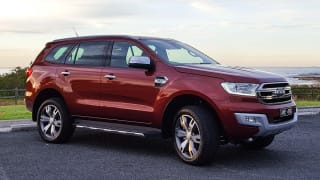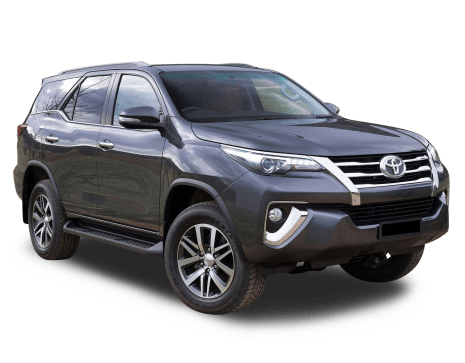
Ford Everest 2017 review
Based on the Ranger pickup truck platform, the Ford Everest launched last year to much fanfare - but is it sufficiently different to warrant its extra cost?
Browse over 9,000 car reviews

Car companies love to be able to make the most of an all-new model, and the best way of doing that is by adding body styles to an existing platform.
Following on from the release of its latest generation HiLux, Toyota turned its attention to creating a more civilian-focused version of the rugged offroader. The result is the seven-seat Fortuner wagon – which can claim to be at least partially Australian, thanks to a good deal of input from Toyota Australia engineers during its development.
Launched in 2015, Toyota has recently refreshed the Fortuner wagon line-up and lopped off a sizable chunk from the recommended retail pricing to boot. Does the base model GX stack up not only against its stablemates, but other four-wheel drive (4WD) wagon competitors?
| Toyota Fortuner 2018: GX | |
|---|---|
| Safety rating | |
| Engine Type | 2.8L turbo |
| Fuel Type | Diesel |
| Fuel Efficiency | 8.6L/100km |
| Seating | 7 seats |
| Price from | $35,090 |
The $42,590 (before on-road costs) Fortuner GX is the beneficiary of a recent $5400 price cut – in the car game, this is a huge chunk of change.
And it’s not like Toyota took stuff out, either. The base GX now gets 17-inch alloy rims instead of steelies, and a set of rear parking sensors to complement the reversing camera.

LED tail-lights, air con, a cloth interior, a chilled bin, a 7.0-inch touchscreen multimedia system and seven seats are all standard fare for the 2.8-litre turbo-diesel powered GX, which comes stock with a six-speed manual gearbox. You’ll need to find $2000 more to spec it with a six-speed auto.
A polyurethane steering wheel, basic multimedia system (with streaming) and rubber mats round out the spec.

The Fortuner is positioned as a proper 4WD seven-seat wagon; hence its position above the more car-like Kluger SUV, but below the more luxurious and larger Prado 4x4.
It also goes up against similarly specced rivals like the Ford Everest Ambiente at $52,990 (Ford will suggest its product targets the Prado, but we disagree), the $48,500 Mitsubishi Pajero Sport GLS seven-seater and Isuzu’s MU-X LS-M ($48,000).

The design of the car is interesting. The front half is all new-gen HiLux, with its beaked nose and stylised grille, while the rear isn’t especially shy, either.

LED tail-lights modernise the look, while small bumps, flourishes and garnishing abounds; have a look around the exterior mirrors, for a start.
With a raised ride height, plastic overfenders and chunky all-terrian tyres, the Fortuner certainly looks every inch the offroader in waiting. Not everyone will warm to its quirky looks, though.
Size-wise, the Fortuner is larger than the Paj Sport but smaller than the Everest. It’s sold as a seven-seater, with the two jump seats in the rear of the car folding up and into the sides of the cargo area.
Unfortunately, it’s not a particularly practical way to carry them when stowed, as the folded seats eat into the rear cargo room quite significantly width-wise. As well, there’s only a flimsy hook arrangement that secures them in the car, along with the need to fold down the inside seat rail before use.

Of course, luggage space is also compromised when the rearmost seats are in use, with just 200 litres of usable space behind the three rows of seats. Volume expands to 1080 litres with the seats stowed.
Once locked in place, they can be accessed via tumbling second-row seats but, given how low they’re mounted, are only suitable for smaller humans.

While the second row gets roof vents and a fan control, there’s no such luck for third rowers.
Row two does get 12-volt power sockets and a pair of fold-up hooks in the front seat backs that can handle up to four kilos of your favourite takeaway or shopping. Leg and headroom is more than adequate, though the seat base is mounted quite high.

There’s also a pair of ISOFIX baby seat mounts and three top-tether points, as well as two cupholders in the centre armrest and bottle holders in each rear door.
Up front, meanwhile, reside a pair of manually operated seats, a polyurethane (read: plastic) steering wheel and a basic 7.0-inch multimedia screen arrangement.
Bottles can be stashed in the doors but – in a first for this reviewer for a long time – the manual version of the Fortuner doesn’t offer cupholders between the front seats. And it’s only their absence that reminds you just how often you use them…

A handful of negatives; the middle belt on the second row is mounted in the roof, and as such is a bit of a pain to access. There’s also no left footrest under the clutch pedal, which is tiresome on a longer trip, and it’s a long way up into the cabin for shorter folks.
The plastic wheel is – just - okay to hold over a longer trip, but it’ll get pretty warm in the sun.
The Fortuner is largely based on the HiLux, and uses its ladder frame chassis, along with its front coil springs. Instead of load-lugging leaf springs in the rear, however, the Fortuner uses coils and a beam axle to give it a better ride quality, at the expense of payload capacity.
It also shares the HiLux’s 2.8-litre turbo-diesel four-cylinder engine, and comes with either a six-speed manual (as tested) or for $2000 more, a six-speed auto.
On the open road, the Fortuner verges on being too firm at lower speeds, especially when it’s unladen, but it’s not unbearable.
The long-legged suspension starts to free up when speeds increase, though, offering a more absorbent ride over lumps, square-edged bumps and corrugations.
Steering is reasonably direct, though not particularly precise, and you need a steady hand on the tiller to stop it wandering off centre – a trait of most 4x4s of this size.
The 2.8-litre engine’s responsiveness is good at part-throttle, and the long travel accelerator pedal is progressive and easy to modulate, while brakes are firm and feelsome. The engine sounds and feels laboured when it’s put under the cosh, though, and runs out of urge as it nears 3000rpm.
Outside noise is kept to a surprisingly low level inside the cabin, too, and visibility is okay, save for the rear three-quarter view, which is completely blocked by those rearmost seats.
We didn’t get to test the GX in real off-road conditions, save for a few drives up and down a rutted, gravelly access road that would bedevil a stock SUV or hatchback. The Fortuner simply yawned at it.
The (1GD-FTV) turbo four-cylinder diesel sourced from the HiLux delivers maximum power of 130kW at 3400rpm, and peak torque of 420Nm between 1400 and 2600rpm – 30Nm less than the auto version.

Linked to an Aisin-built six-speed manual, it’s a relatively quiet and pleasingly smooth, tractable engine. The manual misses out on the rev-matching button found in the HiLux, that works to smooth downchanges out, but an idle-up switch works to hold engine revs higher for off-road work.
Speaking of which, the Fortuner comes with a high range 2WD/4WD and low-range 4WD system activated by a dial on the centre console, while a locking rear diff is also stock. The manual variant also offers a slightly higher braked towing capacity of 3000kg, versus the auto’s 2800kg.
Against a claim of 7.8 litres per 100km on the combined fuel economy cycle, we returned a dash-indicated figure of 8.6L/100km over 590km of testing.
The Fortuner's 80-litre tank offers a theoretical range of around 1000km between fills.
Basic Warranty
3 years / 100,000 km warranty
ANCAP Safety Rating

Offering seven airbags, a reversing camera and sensors as well as stability and traction control, the Fortuner offers a maximum five-star ANCAP score. It does miss out on AEB, adaptive cruise control and lane departure warning, though, but features trailer sway control as standard, which is a good addition.
Toyota offers a fixed service program for the Fortuner of $240 per service for the first six services over three years or 60,000km. Service intervals of 12 months or 10,000km are suggested.
A three year/100,000km warranty is provided as standard.
While lopping almost 10 per cent off the original RRP will certainly annoy early adopters, the price cuts give the Fortuner a clear-cut advantage over its nearest rivals.
The Fortuner is a pretty niche vehicle in a market crowded with similar large-ish seven-seat wagons, but it offers off-road abilities road-going SUVs couldn’t hope to match, along with capacity for up to seven and a pretty decent towing capacity, to boot.
| Vehicle | Specs | Price* | |
|---|---|---|---|
| GX | 2.8L, Diesel, 6 SP AUTO | $35,090 – 41,800 | 2018 Toyota Fortuner 2018 GX Pricing and Specs |
| GXL | 2.8L, Diesel, 6 SP AUTO | $39,380 – 46,310 | 2018 Toyota Fortuner 2018 GXL Pricing and Specs |
| Crusade | 2.8L, Diesel, 6 SP AUTO | $45,870 – 53,350 | 2018 Toyota Fortuner 2018 Crusade Pricing and Specs |
| Price and features | 8 |
|---|---|
| Design | 7 |
| Practicality | 7 |
| Driving | 7 |
| Under the bonnet | 7 |
| Efficiency | 8 |
| Safety | 7 |
| Ownership | 8 |
$29,990
Lowest price, based on 93 car listings in the last 6 months